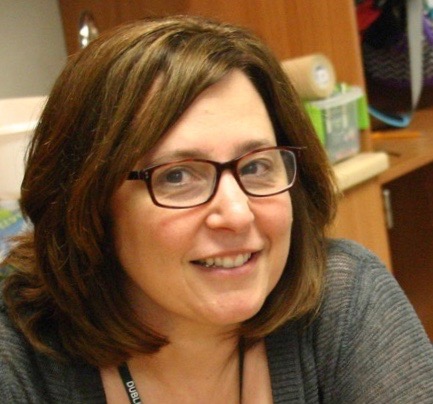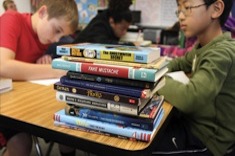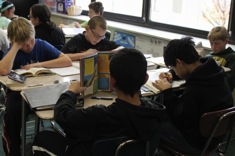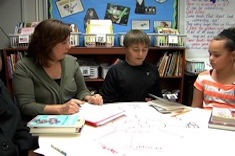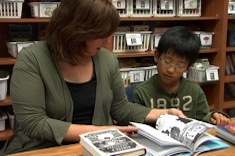A few years ago, I decided to read The One and Only Ivan to my third graders early in the year. It is one of my favorite books, and I was excited to share it. They enjoyed the book, but I found myself stopping to explain a lot that went over their heads. I realized that although this book started good conversations, it wasn’t really supporting them as readers since I was doing most of the thinking work. I learned that although I love this book, it would have been a more accessible read-aloud in fourth or fifth grade.
I have learned over and over again that when I push my students to books they aren’t yet ready for, they comprehend them at a basic level but miss a lot that is important to understanding the story with any depth.
The books many third graders read and love are often the books that help them grow into lifelong readers. It is in third grade that they often fall in love with a series and stick with that series for months on end. It is the age when they begin to build those habits that they’ll carry with them.
But books third graders read are not often the books that we as adults love. I have talked to countless teachers and parents who eagerly await the days when they can share some of their favorite childhood novels with children. We wait for the days when we can share books like Walk Two Moons by Sharon Creech and Holes by Louis Sachar.
I used to be a teacher who rushed my students through the Boxcar Children series so that they could get to the “good” books like Bridge to Terabithia. But over the years I’ve learned that if I can keep my eye on the big goal of creating lifelong readers, I can’t rush them through this stage. It is a critical stage in the life of a reader. I have to remember how critical this stage was for me as a reader.
For months in my elementary years, I read the Nancy Drew books. I chose one from my grandmother’s attic each Sunday and never tired of them. I won’t reread them now because I imagine they’ll be disappointing to me as an adult reader. I imagine Nancy is not as deep a character as I remember, and I imagine that the stories are very predictable after reading one or two. But the year in my life that I read a new Nancy Drew book every week was the year I really felt like a reader. I thought about the characters and stories even when I wasn’t reading. I moved from Nancy Drew to the Betsy books to The Secret Seven to other series. No one told me that I had to expand my tastes as a reader or that I should read higher-quality books. Instead they let me move through this important stage and find out what it meant to be a reader who had favorite books and series and authors, a reader who couldn’t wait to get to the next book.
As a third-grade teacher, I have to constantly remember this stage in my reading life and allow my students the same luxury I had—to become a reader with the books that match who they are as eight- and nine-year-olds. But sometimes it is hard to confer with a child and get excited about the seventh Galaxy Zack book. It is difficult to decide to read aloud a book from the Magic Bone series instead of The Tale of Despereaux by Kate DiCamillo. And it is hard to have genuine conversations with students when you don’t love the characters in the same ways they do.
But this stage of reading is too important to not embrace the books our children love and need as readers. We are lucky to have so many authors who are brilliant at understanding eight- and nine-year-olds. We are lucky to have so many authors who work tirelessly to write books that are not only accessible to our readers but engaging and humorous. We are lucky to have authors who write books that help our students fall in love with reading. I’ve been back in a third-grade classroom for three years, and in those years I’ve done some things that have helped me appreciate these books in new ways. Here are some things I do to build my understanding and respect for these books.
Read One Book in Each Series
I commit to reading one (and only one) book in each series that I have in the classroom. I find that one book in a series is enough for me to know the series, structure, and characters to support my students. The first book in a series is not always the best or most interesting, but it often sets the stage and helps me appreciate what is unique about the series. I do much of this reading in the summer. I take a few summer days and work through a stack of new-to-me transitional series books. These are not my favorite reading days, but they are definitely important.
Take Recommendations
I take recommendations from students. Last year I discovered the Branches books by Scholastic when one of my students shared Owl Diaries with me. This year I added The Haunted Library series by Dori Hillestad Butler and the Rider Woofson series by Walker Styles to our classroom library because my students discovered them first and begged me to buy them.
Listen
I listen when my students talk about the books and characters they love. I realize that after reading several books in a series, my students know the characters far better than I do, and they help me see what is interesting about them from a child’s perspective. I tend to read these books rather quickly, but the characters often have more to them than I notice on my first read. I listen to understand what is relatable for my students.
Read Aloud
I use the first several weeks of read-aloud to share the first book in five or six series that will be important series through the year. I read books like Galaxy Zack and Lulu and the Brontosaurus, hoping they will hook a few readers and to begin conversations about series we love. I also find that when I read these series books aloud to a class and make time for talk, I enjoy them much more than I do when I read them on my own. Experiencing the stories together and hearing the perspectives of my students helps me genuinely appreciate what they have to offer.
Find New Series
I am always on the lookout for new series. There are many high-quality series books. This year we were excited about Kate DiCamillo’s new series, Tales from Deckawoo Drive. I am always happy to find a new series that is accessible at this transitional stage and that will hook some readers.
Keep an Eye on Release Dates
I keep my eye on when the next book in a popular series is due out. I want my kids to anticipate books by favorite authors, so I build on that by making sure to get new books in a series soon after they are released. They become the most popular books in the classroom for a few weeks. This helps builds excitement and conversation.
I have learned over and over again that kids will move beyond this stage of reading and that they’ll do it on their own time. And, I have accepted the fact that they may not move past it while they are in third grade. As a third-grade teacher I have to remember that I read beside my students for only nine months of their life as a reader. It might be the nine months that they are stuck in a series I don’t actually enjoy, and that is okay.


